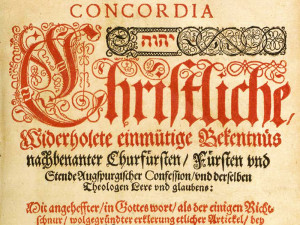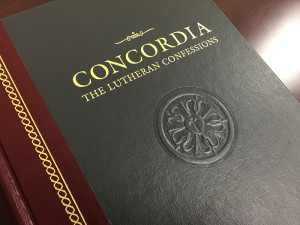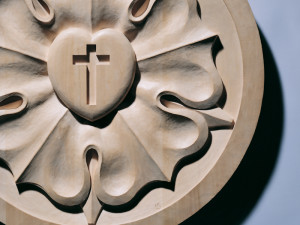by Rev. Mark Bestul
For the first of the monthly studies on the Formula of Concord, see the blog post from Rev. Aaron Moldenhauer dated May 23.
 As with the other confessions of the Book of Concord, the study of the Formula of Concord includes a study of history and theology – (1) the historical situation that led to the topic being considered and (2) the theological struggle, flowing from the historical situation, that continues well after the ‘scenes’ and ‘actors’ of history are no longer center stage. So then, the Confessions are not just a history book of what was once at stake for true Lutheran confession, but they are also a description of what is still at stake for true Lutheran confession. As the first post in this series explained, the 16th century Lutherans help our generation learn about these issues by considering the “Status of Controversy,” the “Affirmative Statements” and the “Negative Statements” for each article. Where the “Status of the Controversy” helps us understand the history of the issue, the “Affirmative Statements” and the “Negative Statements” not only help us understand how the issue was historically resolved, but also how we must – for the sake of sound doctrine – handle these issues to defend Truth from error today.
As with the other confessions of the Book of Concord, the study of the Formula of Concord includes a study of history and theology – (1) the historical situation that led to the topic being considered and (2) the theological struggle, flowing from the historical situation, that continues well after the ‘scenes’ and ‘actors’ of history are no longer center stage. So then, the Confessions are not just a history book of what was once at stake for true Lutheran confession, but they are also a description of what is still at stake for true Lutheran confession. As the first post in this series explained, the 16th century Lutherans help our generation learn about these issues by considering the “Status of Controversy,” the “Affirmative Statements” and the “Negative Statements” for each article. Where the “Status of the Controversy” helps us understand the history of the issue, the “Affirmative Statements” and the “Negative Statements” not only help us understand how the issue was historically resolved, but also how we must – for the sake of sound doctrine – handle these issues to defend Truth from error today.
The first article of the Formula of Concord, “Original Sin,” results from an argument regarding the true nature of man. The status of the controversy as it arose in the 16th century (1560-1575) included one camp of theologians who believed that man was in his essence (by definition) sinful, while the other camp maintained that original sin is an “accidens” that plagues man, but is not the very substance of man. The article resolves the dispute by maintaining that original sin is not essentially part of man (if so, Jesus – the perfect man – could not be true man!), but is a “spiritual poison and leprosy.” This condition is man’s from conception, not according to the Creation, but the Fall.
The second article of the Formula of Concord, “Free Will,” resolves a controversy that actually chronologically preceded the issues surrounding the first article. From 1555 and 1560, some Lutheran theologians taught that man by his own natural powers could cooperate in his conversion, while other Lutheran theologians argued that God alone makes the unregenerate soul regenerate. One can understand why this historical argument led to the controversy about original sin, while one can simultaneously see why the proper understanding of original sin determines the proper outcome of this argument. Thus, this controversy was settled by the Formula of Concord’s second article, which maintains that – while man has free will in worldly matters (such as which shirt in the closet to wear on a given morning), man – because of original sin – has no freedom to help himself in conversion.
Notice that both of these issues are still extremely relevant and important today. There’s nothing new under the sun; the errors then are sadly still held today by entire church bodies (even if “repackaged”) and taught to people in their pews! Thus, how necessary that we learn from each of these controversies – not just historically, but theologically:
Article I: Original Sin
 1. Read the Solid Declaration, para.3-4 (Concordia, 2nd Edition, 512). How do these paragraphs highlight the necessity of doctrinal clarity on this matter?
1. Read the Solid Declaration, para.3-4 (Concordia, 2nd Edition, 512). How do these paragraphs highlight the necessity of doctrinal clarity on this matter?
2. Paragraph 7 of the Solid Declaration says, “God is not a creator, author, or cause of sin…. [and, at the same time] God at the present day still creates and makes the human nature in people.” How does this two-part comment help define original sin as accidens rather than substance, the work of the devil rather than the work of God?
3. More than “lack of righteousness” (para. 10), original sin is also “a deep, wicked, horrible, fathomless, mysterious, and unspeakable corruption of the entire human nature and all its powers” (para. 11). How does this truth deepen our sadness in hearing that, while Adam was created in the image and likeness of God, the Scriptures say that, after the Fall, Adam’s children were born in the likeness of Adam (Genesis 5:3)?
4. In light of the comment quoted in #2 above, I often explain to folks that we must be able to see the world through “bifocals” – the one “lens” being God’s Creation, the second being Man’s Fall. Ephesians 2:3 says we were “by nature children of wrath.” Which of the “bifocals” is being employed by Paul?
5. Consider the hymn “All Mankind Fell in Adam’s Fall,” LSB #562, as it confesses Romans 5:12-21 and original sin. How does this confession deepen our understanding of our utter need for the Second Adam, He who is born not in the likeness of Adam, but in the likeness of God?
Article II: Free Will
 1. Article I, para. 14 previews this second article. Does Christ’s death “make” us righteous or “declare” us righteous? How does the “courtroom language” of justification help us understand that even after Christ’s death, we must still confess, “I, a poor miserable sinner…”? How does this help us better understand what we might expect to read in Luther’s Bondage of the Will?
1. Article I, para. 14 previews this second article. Does Christ’s death “make” us righteous or “declare” us righteous? How does the “courtroom language” of justification help us understand that even after Christ’s death, we must still confess, “I, a poor miserable sinner…”? How does this help us better understand what we might expect to read in Luther’s Bondage of the Will?
2. Read Article II, para. 2’s (p. 520) explanation about the “four unique conditions.” Why is it extremely important to remember this is a discussion about the unregenerate becoming regenerate, not about those who are already regenerate? How does failure to consider that important context lead people to erroneously think that the regenerate man (“New Adam”) does not / is not expected to / cannot cooperate in the baptismal life of sanctification?
3. Read the Solid Declaration’s fifth paragraph. How is this echoed by the Small Catechism’s explanation of the third article of the Creed?: “I cannot by my own reason or strength believe in Jesus Christ my Lord, or come to him; but the Holy Spirit has called me by the Gospel, enlightened me with his gifts…”
4. Skim the Solid Declaration and count the number of Bible passages referenced that show that Man has no free will to come to faith, nor is man’s heart “neutral” before conversion. Furthermore, paragraphs 48-73 give a detailed explanation of how the unregenerate is converted through the Holy Spirit’s use of Word and baptism. How does all of this teach us to beware of the teachings of those who want us to “choose Jesus” or those who ask “When did you make your decision for Jesus?” or those who claim you can come to faith through some other means (a walk through the woods, a feeling in the heart, powerful music, etc.)?
5. Ought pastors preach to “convince” or preach to “convict”? In other words, when churches try to “package and sell” the Gospel and try to “convince” people of its goodness, what does this imply about their understanding of the unregenerate will – that it is bound or free?
 God safeguard us in the sound Scriptural teaching of Original Sin, our inability to aid in our conversion, and – therefore – our utter dependency on our God who “being rich in mercy, because of the great love with which he loved us, even when we were dead in our trespasses, made us alive together with Christ.” (Ephesians 2:4-5) Indeed, He has made us alive “according to his own mercy, by the washing of regeneration and renewal of the Holy Spirit, whom He poured out on us richly through Jesus Christ our Savior” (Titus 3:5-6).
God safeguard us in the sound Scriptural teaching of Original Sin, our inability to aid in our conversion, and – therefore – our utter dependency on our God who “being rich in mercy, because of the great love with which he loved us, even when we were dead in our trespasses, made us alive together with Christ.” (Ephesians 2:4-5) Indeed, He has made us alive “according to his own mercy, by the washing of regeneration and renewal of the Holy Spirit, whom He poured out on us richly through Jesus Christ our Savior” (Titus 3:5-6).
The Rev. Mark C. Bestul is pastor of Calvary Lutheran Church in Elgin, IL.
